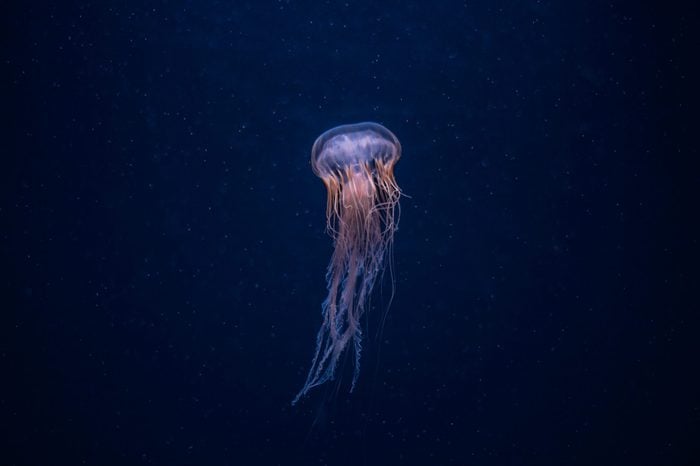
Don’t let these simple creatures fool you
Jellyfish are unusual creatures. They’re neither fish nor jelly (but do look and feel a little gelatinous). Some are among the most colorful animals in the ocean, but it’s best to look but not touch these invertebrates. Not only are they very fragile creatures, but many give a painful sting and some are even deadly. Whether you admire them in an aquarium or try to avoid them in the wild, you won’t be able to get these fascinating jellyfish facts out of your head.
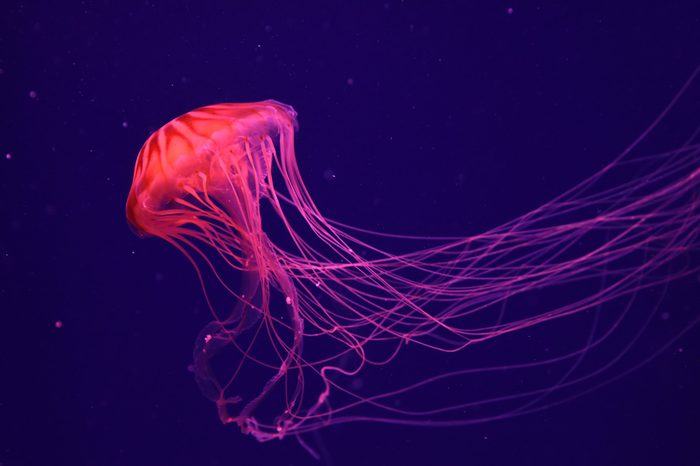
Not all jellyfish are jellyfish
The Smithsonian describes two types of unrelated animals that we call jellyfish. True jellyfish are the bell-shaped animals with long tentacles that float through the world’s oceans. Comb jellyfish, on the other hand, have hairlike cilia, which they use somewhat like a row of oars to propel themselves through the water. Many comb jellies also have a pair of tentacles, but they don’t sting like those of true jellyfish. Instead, their tentacles are sticky to prevent their prey from getting away. Here are 60 other fun facts about animals you probably didn’t know before.
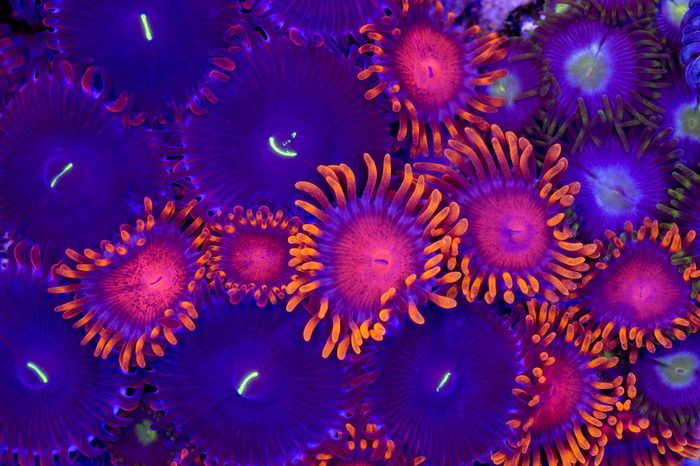
Purple people eaters exist
There are more than 2,000 different species of jellyfish, according to the World Atlas, and some of them have pretty vivid names. The Smithsonian lists pink meanies, fire jellies, and, yes, even purple people eaters. Some friendlier-sounding names are blue blubbers, flower hats, sea walnuts, and busy bottoms. Jellyfish aren’t the only animals with weird names. Here are another 11 funny animal names that don’t sound real (but are).
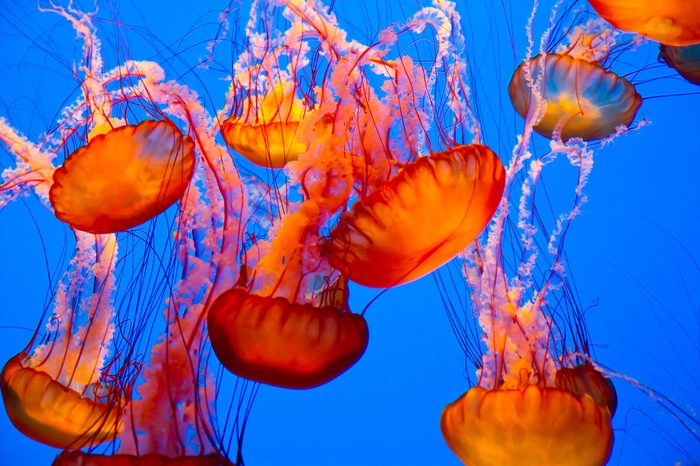
A smack of jellyfish
Here’s a jellyfish fact that might come in handy if you’re on Jeopardy! someday: There are several names for a group of jellyfish. They include smack, bloom, and swarm. Choose the word you prefer depending on whether you think the jellyfish pack looks like a garden of blooming flowers or more like an intimidating pack of stingers, and whether you’re admiring them at an aquarium or if you and your fellow snorkelers are surrounded. Do you know these other hilarious (but totally real) names for groups of animals?
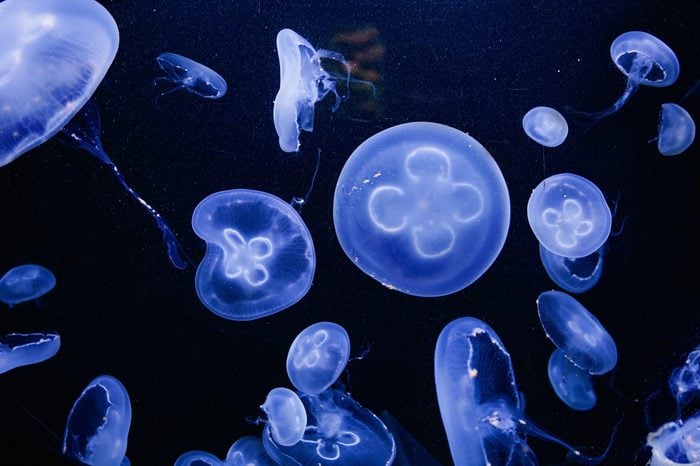
Jellyfish medusas, ephyrae, and polyps
Jellyfish have two main forms in their life cycle that look quite different from each other. Scientific American explains that an adult jellyfish, called a medusa, has a bell-shaped body with tentacles flowing down below it. Young jellyfish, called polyps, look more like sea anemones, with shorter tentacles that flow up above the main body. Polyps are able to “bud” or clone themselves, growing into young jellyfish called ephyrae. Medusas reproduce by releasing sperm and eggs.
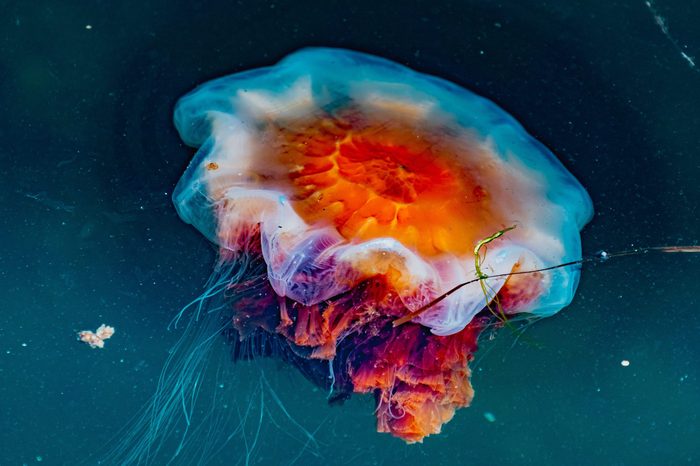
Jellies can get as big as blue whales
Melanie Roberts, Senior Aquarist at SeaWorld Orlando, says that the largest jellyfish in the world is a lion’s mane jellyfish. The body of this beautiful bioluminescent orange jelly can grow up to three feet in diameter. With its 12,000 tentacles that can grow 120 feet long, Oceana.org adds that the lion’s mane jelly compares in size to the planet’s largest animal, the blue whale. Curious what the biggest fish in the sea is? It’s the whale shark, and we bet that you probably don’t know these 11 whale shark facts.
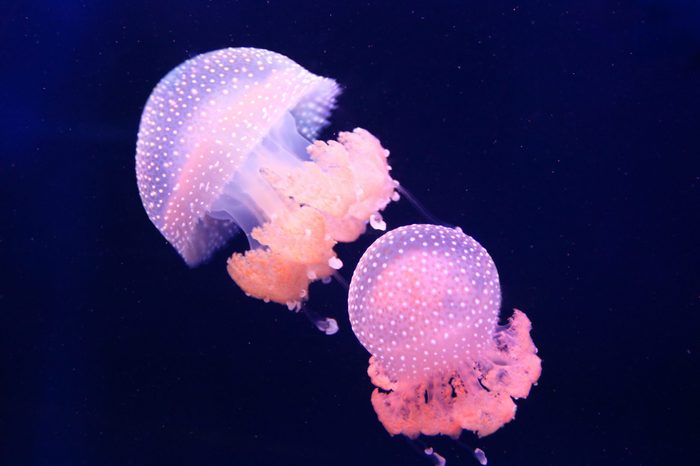
Jellyfish are mostly water
Regardless of their size, jellyfish are mostly made of water. In fact, they’re about 95 percent water. Some more weird jellyfish facts? These creatures don’t have brains, blood, or bones. And most jellyfish don’t have eyes (but the deadly box jellies do). Jellyfish also use their mouths both for eating and for waste elimination. As Mackenzie Neale, jellyfish expert and Director of Animal Care at the Vancouver Aquarium, says, “when you only have a few organs, you need to make the most of each one!”
Jellyfish can also regenerate their tentacles, and can quickly grow and shrink their entire bodies depending on their food supply. One type of jellyfish is even immortal (more on that later). While most jellies live near the surface of the ocean, these are 13 of the weirdest deep-sea creatures lurking down below.
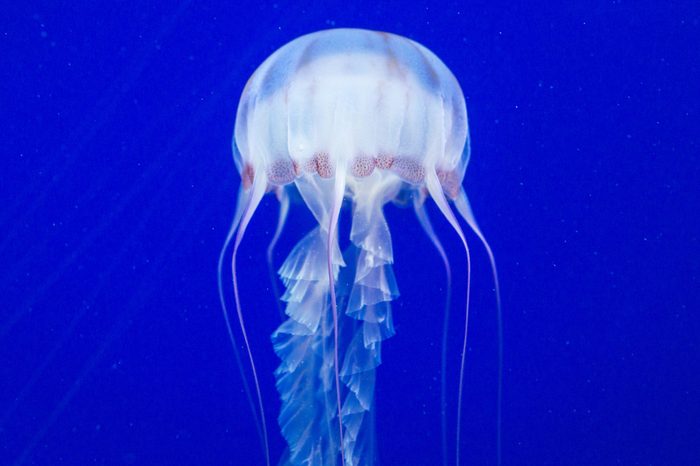
Box jellyfish are as bad as you’ve heard
National Geographic describes box jellyfish as one of the most advanced jellies in the ocean. Unlike most of their jellyfish cousins, box jellyfish not only have eyes—but sophisticated ones with a cornea, iris, lens, and retina. They don’t, however, have a brain or central nervous system. Box jellyfish can also propel themselves through the water at speeds up to four knots, instead of just drifting with the current like most jellies.
Box jellies are the deadliest jellyfish. SeaWorld Orlando says that a box jelly has enough venom to kill 60 people. When humans are stung, they often have heart failure or drown from shock before they can get medical treatment. When they do survive, the pain of the box jellyfish sting can last for weeks. So, stay away from box jellies, and keep an eye out for these other 15 innocent-looking animals that are surprisingly dangerous.
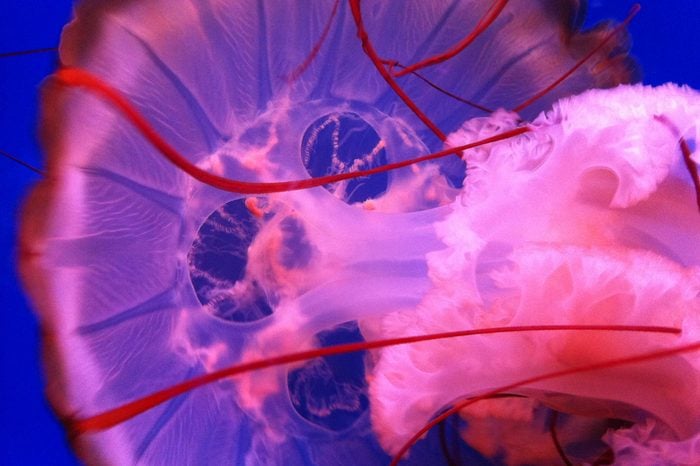
That infamous jellyfish-sting cure is a myth
You know the one we’re talking about. Many people think that if you do get stung by a jellyfish, the best thing to do is to urinate on the sting. Not only would that make for an awkward beach activity, but the Mayo Clinic says it’s also ineffective. Same goes for sprinkling on meat tenderizer, lemon juice, or alcohol. Here are some other old wives’ tales you should really stop believing.
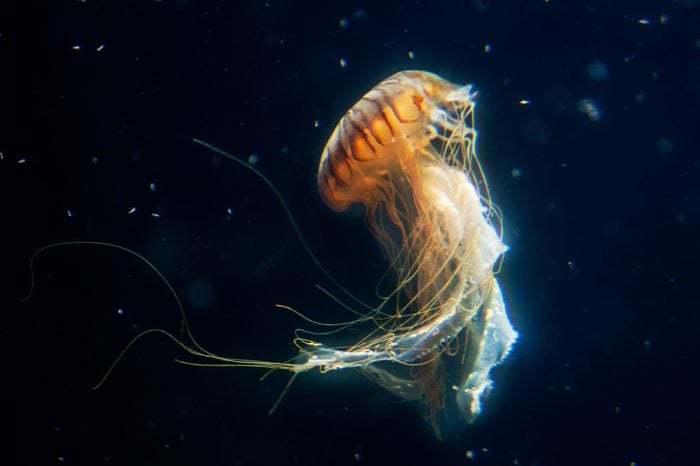
These two things do help a jellyfish sting
So, what should you do if you are stung by a jellyfish? The Guardian describes how rinsing a sting with vinegar helps prevent venom from being released if any parts of the jellyfish are still attached to your skin. Some beaches and snorkel boats keep a spray bottle of vinegar handy, just in case. If you don’t have vinegar handy, use seawater to rinse the stung area and remove the tentacles, which will continue to sting as long as they’re touching your skin. Soaking the injury in hot water for 20 to 45 minutes can also help relieve pain. Seek medical attention if you have shortness of breath, hives, or other symptoms of allergic reaction or shock.
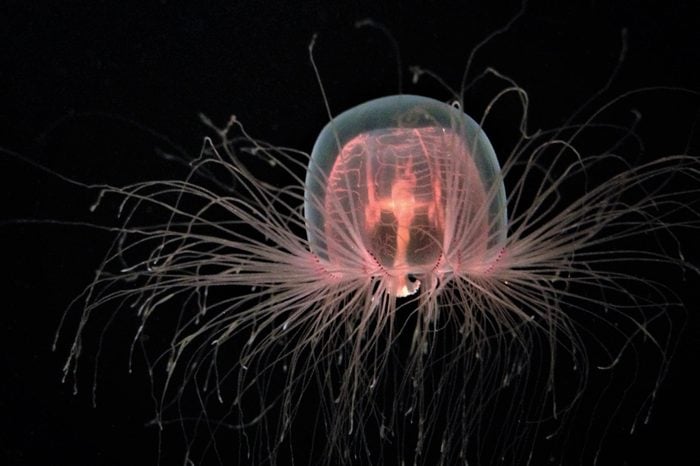
The immortal phoenix of jellyfish
This is definitely one of the strangest jellyfish facts: There’s a kind of jellyfish that behaves like the ever-regenerating Fawkes the Phoenix in Harry Potter. It’s called the Turritopsis dohrnii jellyfish. As it ages, or if it gets injured or starves, it can turn itself back into individual “baby” jellyfish, called polyps. It can then clone itself and grow into new jellyfish that are genetically identical to the first one. It’s one of these 7 immortal animals that can basically live forever.
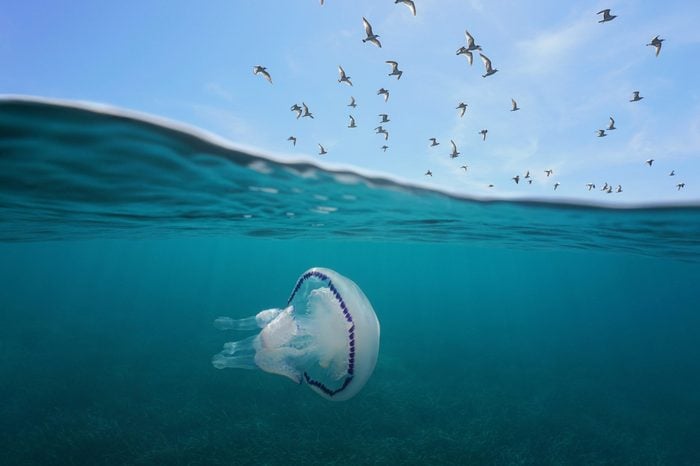
Are jellyfish going to take over the world?
An alarming jellyfish fact reported by the Smithsonian and the World Economic Forum is that jellyfish are reproducing rapidly and congregating in unusual places. Jellyfish caused a massive power outage in the Philippines when they got sucked into a power plant’s cooling pipes. Nuclear power plants in Scotland and Sweden have had to be shut down for the same reason. A swarm of jellyfish that covered 10 square miles and was 35 feet deep stung and killed more than 100,000 salmon at a fish farm off the coast of Ireland.
Scientists believe that jellyfish populations are growing because ocean waters are warming and becoming more acidic. Another factor is the decreasing populations of jellyfish predators and food competitors. Jellyfish also seem to survive just fine in most types of pollution, and floating plastics are prime jellyfish breeding grounds, so cleaner oceans might mean fewer jellyfish. Neale adds that jellyfish can “be considered as a bit of a canary in the coal mine” and a signal for us to take better care of our environment.
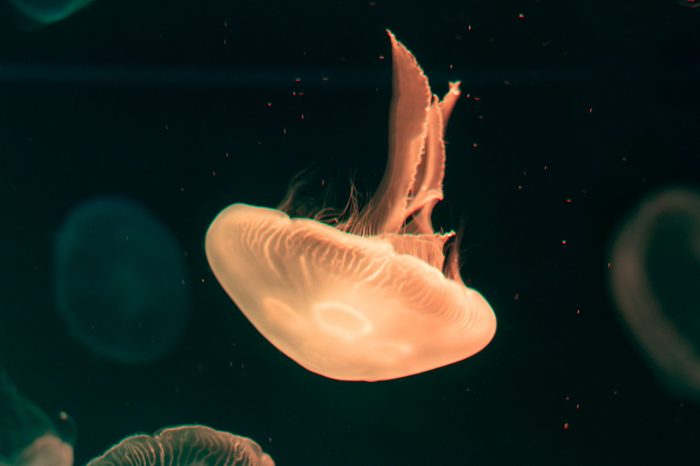
Jellyfish have traveled into space
In testing the effects of gravity, NASA sent a couple thousand jellyfish up into space with astronauts aboard the space shuttle Columbia in 1991, according to The Atlantic. The jellies reproduced while in space just fine, but the space-born animals didn’t function normally when they got back to Earth. The experiment raised concerns that humans born in space also might not be able to function in a normal-gravity environment. Like jellies, humans have calcium sulfate crystals in our bodies, which react to gravity to tell us which way is up. Here are some other animals that made it to space before you did.
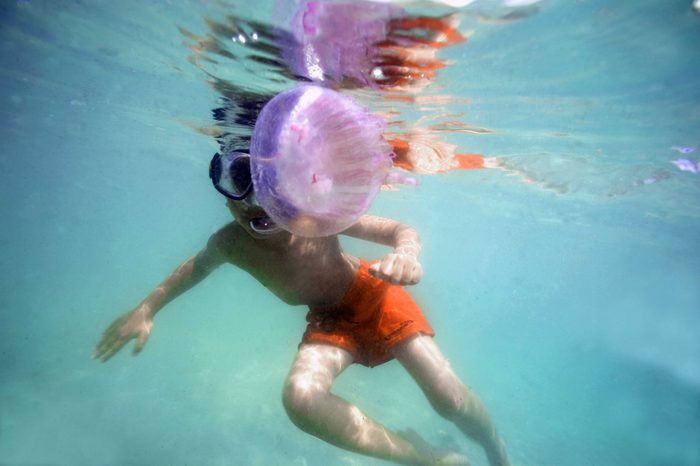
You can swim with jellies that have lost their ability to sting
In the tiny South Pacific nation of Palau, there’s a saltwater lake called Ongeim’l Tketau Jellyfish Lake. As you’d guess by the name, it’s full of jellyfish. Trapped in the lake by receding glaciers 12,000 years ago, the sting of these orange jellyfish has evolved so it no longer affects humans. Jellyfish Lake reopened to snorkelers in December 2018 after the jellyfish population rebounded. There was a significant decrease in the number of jellies in 2016, which scientists believe was due to drought conditions and tourists’ sunscreen. Now that you’re up to speed on your jellyfish facts, check out these 13 things you never knew about manatees—including the one spot in the United States where you can swim with them.
